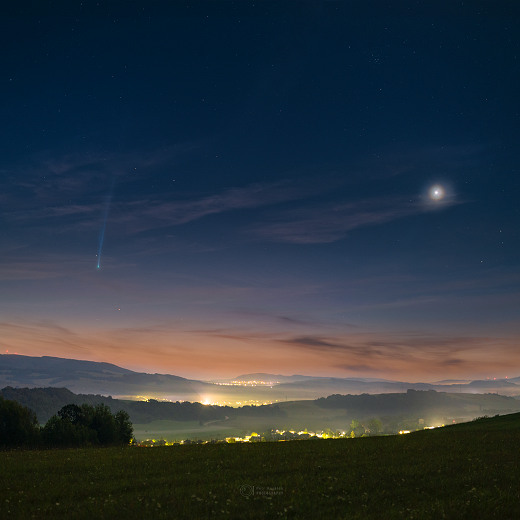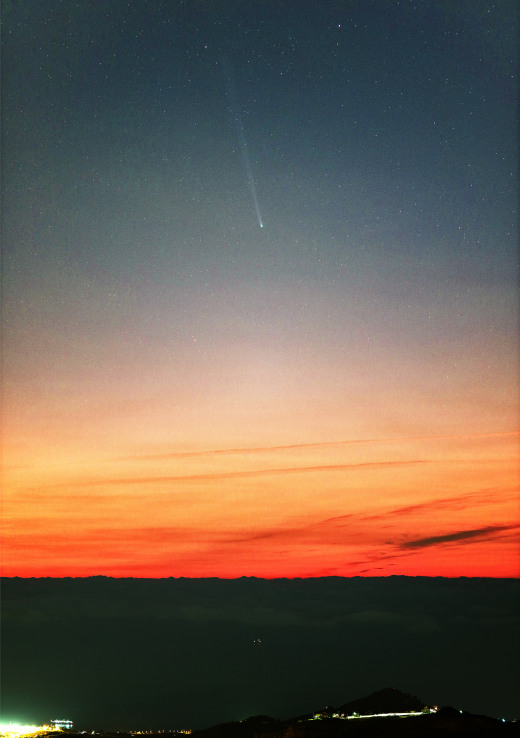#comet

#cryovolcanic #comet 12P/Pons-Brooks is passing by the #Andromeda #Galaxy in the western evening sky. Petr Horálek photographed the wide conjunction from Revúca, #Slovakia:
"This was wild," says Horálek. "On March 5th, I drove 300 km to Telgart, Slovakia, where the forecast predicted clear skies. But the forecast was wrong! When I reached Telgart, the sky was hopelessly cloudy. I almost gave up and was returning home through truly thick fog when, abruptly, the sky cleared. I pulled into a field where the comet was low over the horizon and blindly took this exposure."
It turned out pretty well.
https://spaceweather.com/
#Comet 12P/Pons-Brooks has crossed the threshold of binocular visibility. "It is now a 6th-magnitude object," reports Michael Jaeger, who made this 1-hour animation on March 2nd:

This is an AI Free Zone! Text created by ChatGPT and other Large Language Models is spreading rapidly across the Internet. It's well-written, artificial, frequently inaccurate. If you find a mistake on Spaceweather.com, rest assured it was made by a real human being.
MARCH IS THE BEST MONTH OF THE YEAR FOR AURORAS: Did you know that March is the best month of the year for auroras? It's true. A 75-year study shows that March has more geomagnetically active days than any other month of the year. (October is a close second.) This is due to the Russell-McPherron effect. In short, cracks tend to form in Earth's magnetosphere during weeks around equinoxes, allowing solar wind to spark Northern Lights. Aurora alerts: SMS Text
COMET 12P IS COMING TO LIFE: With a new ice-geyser outburst on Feb. 29th, Comet 12P/Pons-Brooks has crossed the threshold of binocular visibility. "It is now a 6th-magnitude object," reports Michael Jaeger, who made this 1-hour animation on March 2nd:
"It was easy to see in my 6x30 viewfinder," he says. "The view reminded me of galaxy M13 with a 0.5° tail."
Comet 12P/Pons-Brooks is "cryovolcanic." Its surface is dotted with geysers which spew a mixture of liquid hydrocarbons and dissolved gasses when they are warmed by sunlight. There have been at least 6 significant eruptions since last December, one of them an incredible 5 magnitudes: light curve.
Right now, 12P is approaching the sun for a close encounter in April. Between now and then, forecasters expect 12P to brighten 10- to 15-fold, making it a naked-eye object at 3rd to 4th magnitude. This would be true even without any special geyser activity; the whole comet is sizzling as it approaches the sun. If any geysers do erupt in the weeks ahead, it could push the comet to even greater brightness.
Comet 12P has received a lot of attention because it could be visible during the April 8th solar eclipse. During totality, the comet will be close to Jupiter, both about 30 degrees from the eclipsed sun:
Anticipation is building for a rare sight during the April 8th #total #solar #eclipse. In addition to the sun's corona, there's going to be a #comet. 12P/Pons-Brooks will be close to the sun during totality, potentially visible to the naked eye inside the Moon's shadow.
Here's what it looks like right now:

Michael Jaeger photographed the comet from his backyard observatory in Austria on Feb. 16th. "The comet's tail is magnificent," he says. "It is currently more than 2.5 degrees long."
At the moment, 12P is invisible to the naked eye; you need a telescope to see it. However, it is approaching the sun for a close encounter in April. Between now and then, forecasters expect the comet's brightness to increase at least 40-fold to magnitude +4.0. That would make it a borderline naked-eye object just in time for the eclipse.
"Border-line naked eye" doesn't sound spectacular, but 12P may have a trick up its sleeve. The comet is famously variable, with surges in brightness that no astronomer can fully predict. 12P is festooned with ice geysers, old-faithful-like vents that spew plumes of gas and dust into space, cloaking the comet in a veil of sunlight-reflecting material. An eruption of one of these geysers during (or even around the same time as) the #solar-eclipse could catapult it into the realm of magnificent.

Structure in the #Tail of #Comet #12P/Pons-Brooks
#Astronomy #Picture of the Day
the evil ones murdered the true historians
#why do they #lie about our past #story
Scientists research #comet that historians say is impossible! Wilson and Blackett 6th century
https://www.youtube.com/watch?v=MQUCNweO7O4
#Wilson and #Blackett are ridiculed for #research into a subject that eminent scientists from around the world are working on. The weird world of historians and politicians ridiculing a subject they don’t seem to want to #know more about.

Three #Galaxies and a #Comet
#Astronomy #Picture of the Day

#Vega and #Comet #12P/Pons-Brooks
#Astronomy #Picture of the Day

A #DustJet from the #Surface of #Comet #67P
#Astronomy #Picture of the Day

#Comet #Nishimura entered the field-of-view of STEREO's inner Heliospheric Imager (HI-1) on September 17th. This movie shows considerable interaction of the comet's ion tail with the solar wind, along with a possible glancing blow from a coronal mass ejection in the September 22-23 timeframe. Toward the end of the movie, at the start of the day on September 23, the comet appears fainter and the movie appears to slow down. This is due to a pre-planned change in the observing mode for a science campaign unrelated to the comet. The HI-1 image cadence is increased from once every 40 minutes to once every 20 minutes, with a corresponding decrease in exposure time.
https://stereo.gsfc.nasa.gov/gallery/item.shtml?id=stereoimages&iid=238

COMETS LIKE IT HOT: Yesterday, Sept. 17th, #Comet #Nishimura (C/2023 P1) made a close approach to the #sun deep inside the orbit of #Mercury (0.22 AU). The comet survived. Petr Horalek photographed it emerging intact from Mount Lysa in Sabinov, Slovakia:
"Because of the glare of sunset, the comet was not visible to the naked eye, however I was able to photograph it using a 5 second exposure at ISO 1000," says Horalek. "The comet's brightness is hard to estimate. Considering other stars and the comet's location over the horizon, I believe it to be magnitude 2.0 to 2.5."
Horalek's estimate agrees with that of other experienced observers. If the comet remains this bright, it could become easy to see as it recedes from the sun in the evenings ahead.
https://spaceweather.com/

#COMET AT DAWN: Set your alarm for dawn. There is a bright comet in the morning sky. You probably can't see it with the naked eye, but even relatively short exposures with digital cameras are picking up the starlike head and long tail of Comet Nishimura (C/2023 P1):
"This morning, I was successful in photographing Comet #Nishimura from Zahradne, #Slovakia, where the comet appeared against a slightly cloudy sky," says Petr Horalek. "Its tail is so bright that I could see it easily in my backyard telescope."
Latest estimates of the comet's brightness place it at magnitude +4.5. In a dark sky, this would be visible to the unaided eye, but the morning sky is not dark. Cameras are required to pluck the comet from the twilight of dawn. Many photographers are finding that less than a minute of exposure time is enough for a nice picture. Horalek's photo is a stack of 20 second shots (ISO 800).
The mornings ahead will be more difficult. Comet Nishimura is plunging toward the sun for a close encounter inside the orbit of Mercury on Sept. 17th. Increasing glare will challenge astrophotographers.
"I am truly happy I made it at least once to see this beauty!" says Horalek.

#Comet #Nishimura is plunging toward the sun for a close encounter inside the orbit of Mercury on Sept. 17th. Increasing heat is causing it to brighten rapidly. Latest estimates of the comet's brightness place it at magnitude +4.5.
"This is a 4-second exposure (ISO 1600) from the Cabreja Volcano in Vega de San Mateo on Gran Canaria Island," says photographer Frank A. Rodriguez. "What a nice comet!"







